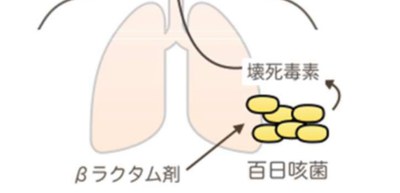
Dermonecrotic toxin in Bordetella pertussis (whooping cough) found to manifest neurotoxicity
May clarify the cause of pertussis encephalopathy
A group of researchers from Osaka University has revealed that dermonecrotic toxin (DNT) in Bordetella pertussis (B. pertussis) caused symptoms similar to those of pertussis encephalopathy in mice.
In B. pertussis infection, pertussis encephalopathy has long been recognized as a rare complication. The disease also infrequently develops encephalopathy as a sequela that may cause death or permanent neurological disorders. Studies from 2001 to 2003 in the United States reported that 33 of 28,998 patients (0.11%) developed encephalopathy.
B. pertussis, a cause of pertussis, produces three representative protein toxins, pertussis toxin (PT), adenylate cyclase toxin (ACT), and dermonecrotic toxin (DNT); however, the pathogenesis of DNT was not well understood. Thus, this group investigated receptors to which necrotic toxin bind, identifying the T-type voltage-gated Ca2+ channel CaV3.1 as a receptor of DNT, which is highly expressed in the nervous system.
Generally, a toxin binds to target cells via an unknown receptor. Thus, considering the possibility that the neurotoxicity of DNT might affect the nervous system, this group performed intracerebral injection of DNT in the cerebral ventricles of mice. As a result, the mice injected with DNT to the brain developed neurological symptoms such as flaccidity of hind limbs and myelin basic protein (MBP) and interleukin-6 (IL-6) levels in the cerebrospinal fluid (CSF) were markedly increased. These clinical manifestations were also reported in cases of pertussis encephalopathy.
However, no neurological symptoms were observed by intracerebral injection with the other major virulence factors of the organisms: pertussis toxin and adenylate cyclase toxin. This strongly suggests the possibility that DNT is a causal factor of pertussis encephalopathy.
They closely examined case reports on pertussis encephalopathy, finding that β-lactam antibiotics, which kill bacteria by inhibiting cell wall synthesis, were administered to patients in 4 of 6 cases. β-lactam antibiotics inhibit the synthesis of the peptidoglycan layer of bacterial cell walls. The researchers also confirmed that treatment of B. pertussis infection with β-lactam antibiotics resulted in the release of active DNT.
Since not all pertussis patients develop encephalopathy, several other factors should be involved in its development. This group’s achievements suggest that DNT is involved in the onset of pertussis encephalopathy as one of the risk factors. Their results opened the possibility that inhibition of activity of DNT can prevent and treat encephalopathy in patients with pertussis. It is anticipated that this will lead to the development of effective methods to control DNT and application to clinical practice.
The article, "Bordetella dermonecrotic toxin is a neurotropic virulence factor using Ca V 3.1as the cell surface receptor," was published in mBio at DOI: https:// 10.1128/mBio.03146-19.
